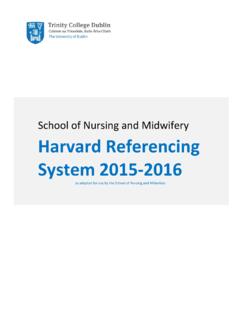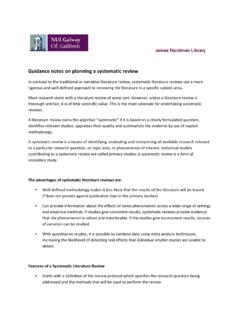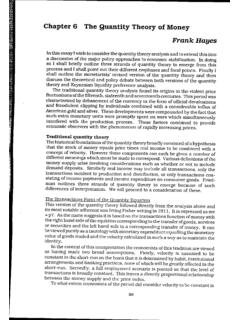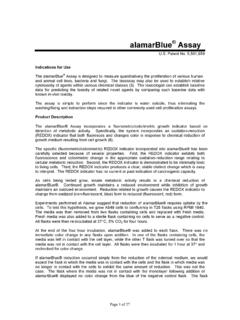Transcription of Analysis of Cell Cycle by Flow Cytometry
1 Analysis of Cell Cycle by Flow Cytometry 301. 22. Analysis of Cell Cycle by Flow Cytometry Piotr Pozarowski and Zbigniew Darzynkiewicz Summary Described are four widely used procedures to analyze the cell Cycle by flow Cytometry . The first two are based on univariate Analysis of cellular DNA content following cell staining with either propidium iodide (PI) or 4',6'-diamidino-2-phenylindole (DAPI) and deconvolution of the cellular DNA content frequency histograms. This approach reveals distribution of cells in three major phases of the Cycle (G1 vs S vs G2/M) and makes it possible to detect apoptotic cells with fractional DNA content. The third approach is based on the bivariate Analysis of DNA. content and proliferation-associated proteins. The expression of cyclin D, cyclin E, cyclin A, or cyclin B1 vs DNA content is presented as an example. This approach allows one to distinguish, for example, G0 from G1 cells , identify mitotic cells , or relate expression of other intracellular proteins to the cell Cycle position.
2 The fourth procedure relies on the detection of 5'-bromo-2'- deoxyuridine (BrdU) incorporation to label the DNA-replicating cells . Key Words: Flow Cytometry ; cellular DNA content; cyclins; BrdU incorporation; mitosis. 1. Introduction A variety of flow or cytometric methods to analyze the cell Cycle progres- sion have been developed over the past three decades. These methods can be grouped into three categories: 1. In the first are the methods that rely on a single time point ( snapshot ) cell measurement. This Analysis may be either univariate, generally based on mea- surement of cellular DNA content alone (1), or multivariate (multiparameter), when in addition to DNA content another cell attribute is measured (2 4). The additional attribute is generally a metabolic or molecular feature that correlates with a rate of cell progression through the Cycle or is a marker the cell prolifera- tive potential or quiescence. The single time-point measurement reveals the per- centage of cells in G1 vs.
3 S vs. G2/M, but it does not provide information on cell Cycle kinetics. The duration of each phase, however, can be estimated from the percentage of cells in this phase if the length of the cell Cycle (or the doubling time of cells in the culture) is known. From: Methods in Molecular Biology, vol. 281: Checkpoint Controls and Cancer, Volume 2: Activation and Regulation Protocols Edited by: Axel H. Sch nthal Humana Press Inc., Totowa, NJ. 301. 302 Pozarowski and Darzynkiewicz 2. In the second group are the methods that rely on time-lapse measurements of cell populations synchronized in the Cycle , or whose progression through the Cycle was halted by the agent arresting them at a specific point of the Cycle . These methods reveal kinetics of cell progression through the Cycle . An example of such methods is the stathmokinetic approach, where cells are arrested in mitosis, , by vinblastine or colcemide, and the rate of cell entrance into mitosis ( cell birth rate) is estimated from the slope representing a cumulative increase in percentage of mitotic cells as a function of the time of the arrest (5).
4 3. Methods of the third category are based on the detection of incorporation of the thymidine analog 5'-bromo-2'-deoxyuridine (BrdU), often combined with DNA. content measurements. They may be either single time-point measurements or use the time-lapse strategy. The incorporated BrdU is detected either cytochemically, based on the use of the DNA dyes, such as Hoechst 33258, whose fluorescence is quenched by BrdU (6), or immunocytochemically, using fluoresceinated BrdU-antibodies (7). The time-lapse measurement of the cohort of BrdU-labeled cells allows one to estimate their rate of progression through different points of the cell Cycle (8). Only a few methods are presented in this chapter. In Subheadings and , two methods are presented that rely on the univariate Analysis of cellular DNA content. The first utilizes propidium iodide (PI) as the DNA fluorochrome and requires blue light as the excitation source ( , 488 nm argon ion laser). Because PI also stains double-stranded RNA, the latter is removed by the addi- tion of RNase A to the staining solution.
5 In the second protocol, the UV-light- excitable 4',6'-diamidino-2-phenylindole (DAPI) is used as a DNA-specific fluorochrome. Cell staining with DAPI is simpler, as it does not require incu- bations with RNase, and is generally preferred when a cytometer that has a UV. light excitation source is available. In Subheading , the Analysis of cellular DNA content, combined with the expression of proliferation-associated pro- teins, is described. The method is illustrated by demonstrating the characteris- tic expression of cyclins D1, E, A, or B1 in normal cells , but this approach may be used to measure the expression of other intracellular antigens in relation to the cell Cycle position. The immunocytochemical detection of incorporated BrdU, combined with the Analysis of DNA content, is presented in Subhead- ing More detailed descriptions of these and other methods, their modifi- cations and applicability to different cell systems, as well as advantages and limitations, are provided in numerous chapters of the methodology books spe- cifically devoted to the cell Cycle and Cytometry (9 15).
6 2. Materials 1. Flow cytometer. A variety of models of flow cytometers of different makers can be used to measure cell fluorescence following staining according to the proce- dures listed under Subheading The manufacturers of the most common flow Analysis of Cell Cycle by Flow Cytometry 303. cytometers are Becton Dickinson Immunocytometry Systems, Beckman/Coulter Inc., DACO/Cytomation, and PARTEC GmbH. 2. The software used to deconvolute the DNA content frequency histograms, to estimate the proportions of cells in the respective phases of the Cycle , is available from Phoenix Flow Systems and Verity Software House (see Note 1). 3. Centrifuge that can accommodate 5-mL tubes. 4. PI staining solution: (v/v) Triton X-100, 10 g/mL PI (Molecular Probes, Inc.), and 100 g/mL DNase-free RNase A in PBS. 5. PBS (phosphate buffered saline, Dulbecco PBS): mM NaCl, mM. KCl, mM Na2 HPO4, mM CaCl2, mM MgCl2. 6. DAPI staining solution: (v/v) Triton X-100 and 1 g/mL DAPI (Molecular Probes, Inc.) in PBS.
7 7. Monoclonal or polyclonal antibodies (Abs) applicable to cell Cycle Analysis , in- cluding cyclin Abs (provided, , by DACO Corporation, Sigma Chemical Co., Upstate Biotechnology Incorporated, Biosciences/PharMingen, and Santa Cruz Biotechnology, Inc.). 8. Cell permeabilizing solution: Triton X-100, sodium azide in PBS. 9. Rinsing solution: 1% bovine serum albumin (BSA), sodium azide in PBS. 10. DNA denaturation buffer: mM Na-EDTA in 1 mM Na-cacodylate; adjust pH to To make M stock solution of cacodylate buffer, dissolve g Na(CH3)2 As2 3H2O in 100 mL H2O, take 50 mL of this solution, add to it mL of M HCl, and adjust volume to 200 mL with H2O. 11. Diluting buffer: Triton X-100, (w/v) BSA in PBS. 12. M phosphate buffer, pH (mixture of 81 vol of M Na2 HPO4 with 19 vol of M KH2PO4). 3. Cellular DNA Content Measurement Cell Staining With PI. 1. Suspend approx 106 cells in mL of PBS. Vortex gently (approx 5 s) or gently aspirate several times with a Pasteur pipet to obtain a mono-dispersed cell sus- pension, with minimal cell aggregation.
8 2. Fix cells by transferring this suspension, with a Pasteur pipet, into centrifuge tubes containing mL of 70% ethanol, on ice. Keep cells in ethanol for at least 2 h at 4 C. cells may be stored in 70% ethanol at 4 C for weeks. 3. Centrifuge the ethanol-suspended cells for 5 min at 300g. Decant ethanol thor- oughly. 4. Suspend the cell pellet in 5 mL of PBS, wait approx 30 s and centrifuge at 300g for 5 min. 5. Suspend the cell pellet in 1 mL of PI staining solution. Keep in the dark at room temperature for 30 min, or at 37 C for 10 min. 6. Transfer sample to the flow cytometer and measure cell fluorescence. Maximum excitation of PI bound to DNA is at 536 nm, and emission is at 617 nm. Blue (488. nm) or green light lines of lasers are optimal for excitation of PI fluorescence. 304 Pozarowski and Darzynkiewicz Emission is measured using the long-pass 600- or 610-nm filter (for data acquisi- tion, interpretation, and possible pitfalls, see Notes 1 5). Staining With DAPI. 1. Suspend the cell pellet in 1 mL of DAPI staining solution.
9 Keep in the dark, at room temperature, for 10 min. 2. Transfer the sample to the flow cytometer and measure cell fluorescence. Maxi- mum excitation of DAPI bound to DNA is at 359 nm, and emission is at 461 nm. For fluorescence excitation, use the available UV light laser line at the wave- length nearest to 359 nm. When a mercury arc lamp serves as the excitation source, use a UG1 excitation filter. A combination of appropriate dichroic mir- rors and emission filters should be used to measure cell fluorescence at wave- lengths between 450 and 500 nm (for data acquisition, interpretation, and possible pitfalls, see Notes 1 5). Cellular DNA Content and Expression of Proliferation-Associated Proteins 1. Fill 5-ml polypropylene tubes with mL of methanol (or 70% ethanol; see Note 6). Keep tubes on ice. 2. Suspend 1 2 106 cells in mL of PBS. Fix the cells by transferring this suspension with a Pasteur pipet into the ice-cold methanol tube. Keep cells in the fixative at 20 C at least overnight (the cells can be stored in the fixative at 20 C for days).
10 3. Centrifuge at 300g for 3 min. Resuspend the cell pellet in 5 mL PBS. Keep for 5. min at room temperature. Spin at 200g for 5 min. 4. Resuspend the cells in mL of the permeabilizing solution. Keep at room tem- perature for 5 min. Centrifuge as above. 5. Resuspend cell pellet in 100 L of the rinsing solution that contains the primary Ab. Follow instructions supplied by the vendor regarding the final titer of the supplied antibody ( g of the Ab per 106 cells suspended in 100 L is generally optimal). Incubate 60 min at room temperature with gentle agitation or overnight at 4 C (see Notes 6 and 7). 6. Add 5 ml of the rinsing solution. Centrifuge at 300g for 5 min. 7. Use the isotype immunoglobulin as a negative control (see Note 7). Process as in steps 5 and 6. 8. Resuspend cells in 100 L of rinsing solution that contains the fluoresceinated secondary Ab, generally at a final 1:20 to 1:40 dilution. Incubate at room tem- perature for 30 60 min, gently agitating. 9. Add 5 mL of the rinsing solution, centrifuge at 300g for 5 min.
















